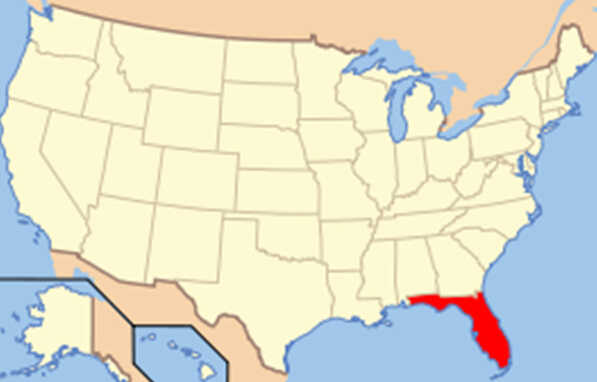

Florida is a state in the southeastern region of the United States, bordered to the west by the Gulf of Mexico, to the north by Alabama and Georgia, to the east by the Atlantic Ocean, and to the south by the Straits of Florida. Florida is the 22nd most extensive, the 4th most populous, and the 8th most densely populated of the 50 United States. The state capital is Tallahassee, the largest city is Jacksonville, and the largest metropolitan area is the Miami metropolitan area.
Much of Florida is a peninsula between the Gulf of Mexico, the Atlantic Ocean, and the Straits of Florida. Its geography is notable for a coastline, omnipresent water and the threat of hurricanes. Florida has the longest coastline in the contiguous United States, encompassing approximately 1,350 miles (2,170 km), and is the only state that borders both the Gulf of Mexico and the Atlantic Ocean. Much of the state is at or near sea level and is characterized by sedimentary soil. The climate varies from subtropical in the north to tropical in the south. Some of its most iconic animals, such as the American alligator, crocodile, Florida panther and the manatee, can be found in the Everglades National Park.
Since the first European contact was made in 1513 by Spanish explorer Juan Ponce de León – who named it La Florida ([la floˈɾiða] "Flowery Land") upon landing there during the Easter season, Pascua Florida – Florida was a challenge for the European colonial powers before it gained statehood in the United States in 1845. It was a principal location of the Seminole Wars against the Indians, and racial segregation after the American Civil War. Today, it is distinguished by its large Hispanic community, and high population growth, as well as its increasing environmental concerns. Its economy relies mainly on tourism, agriculture, and transportation, which developed in the late 19th century. Florida is also known for its amusement parks, the production of oranges, and the Kennedy Space Center.
Florida culture is a reflection of influences and multiple inheritance; Native American, European American, Hispanic and African American heritages can be found in the architecture and cuisine. Florida has attracted many writers such as Marjorie Kinnan Rawlings, Ernest Hemingway and Tennessee Williams, and continues to attract celebrities and athletes. It is internationally known for golf, tennis, auto racing, and water sports.
Geology
The Florida peninsula is a porous plateau of karstlimestone sitting atop bedrock known as the Florida Platform. The emergent portion of the platform was created during the Eocene to Oligocene as the Gulf Trough filled with silts, clays, and sands. Flora and fauna began appearing during the Miocene. No land animals were present in Florida prior to the Miocene.
The largest deposits of potash in the United States are found in Florida.
Extended systems of underwater caves, sinkholes and springs are found throughout the state and supply most of the water used by residents. The limestone is topped with sandy soils deposited as ancient beaches over millions of years as global sea levels rose and fell. During the last glacial period, lower sea levels and a drier climate revealed a much wider peninsula, largely savanna. The Everglades, an enormously wide, very slow-flowing river encompasses the southern tip of the peninsula. Sinkhole damage claims on property in the state exceeded a total of $2 billion from 2006 through 2010.
Earthquakes and tsunamis
Florida is tied for last place as having the fewest earthquakes of any U.S. state. Because Florida is not located near any tectonic plate boundaries, earthquakes are extremely rare.
In January 1879, a shock of Mercalli intensity scale VI occurred near St. Augustine. There were reports of heavy shaking that knocked plaster from walls and articles from shelves. Similar effects were noted at Daytona Beach 50 miles (80 km) south. The tremor was felt as far south as Tampa and as far north as Savannah, Georgia.
In January 1880, Cuba was the center of two strong earthquakes that sent severe shock waves through the city of Key West.
The shock from the earthquake at Charleston, South Carolina, in 1886 was felt throughout northern Florida, ringing church bells at St. Augustine and severely jolting other towns along that section of Florida's east coast. Jacksonville residents felt many of the strong aftershocks that occurred in September, October, and November 1886.
In 2006, a magnitude 5.8 earthquake centered about 260 miles (420 km) southwest of Tampa in the Gulf of Mexico sent shock waves through southwest and central Florida. No damage was reported.



















